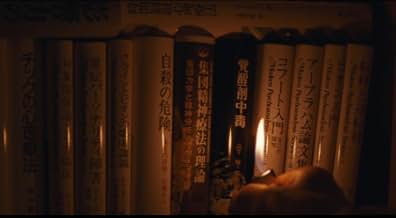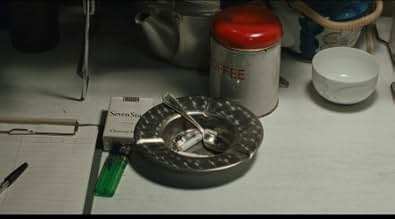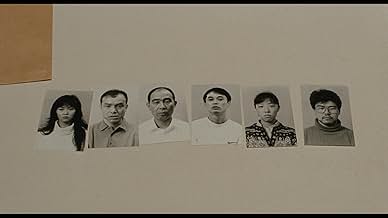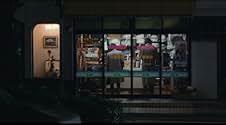Un détective frustré enquête sur plusieurs meurtres effroyables commis par des personnes qui n'ont aucun souvenir de ce qu'elles ont fait.Un détective frustré enquête sur plusieurs meurtres effroyables commis par des personnes qui n'ont aucun souvenir de ce qu'elles ont fait.Un détective frustré enquête sur plusieurs meurtres effroyables commis par des personnes qui n'ont aucun souvenir de ce qu'elles ont fait.
- Prix
- 9 victoires et 2 nominations au total
Histoire
Le saviez-vous
- Gaffes(at around 51 mins) In Japan, they drive on the left side of the road and the steering wheel is on the right side of the car. In every scene in this picture that's the case - except one. When the detective leaves in his car to go to the hospital because Mamiya has turned up there, the steering wheel is on the left and he drives on the right side of the road.
- Citations
Kunio Mamiya: All the things that used to be inside of me... now they are all outside.
- Générique farfeluThere are no opening credits, with the exception of the movie's title.
- ConnexionsEdited into Cure: or How to Be Happy While Saving the Species (2017)
Commentaire en vedette
This movie has a simple premise and a simple story that is nevertheless explored in an incredibly delicate and talented way. Kiyoshi Kurosawa is an extremely talented individual and perhaps the only writer/director who is able to simultaneously scare and mentally challenge me at the same time (note that very few are capable of doing one or the other). Although the writing is very good (story and dialogue), Kurosawa's real strength is his ability to represent visually the progressive denouement of his story. He rather subtly show you and let your imagination and intellect figure it out for you than to spell out bluntly what the straightforward storyline should be. It does not, however, get to the point of chaotic untidiness or pointlessness, for he is able to guide you slowly along the way (I would then say that he is slightly easier to follow than David Lynch is, but then again who is not). He uses here a strikingly effective technique where he shows you a room from one angle and later lets you discover that room more and more as the movie advances. His camera shots are always well planned and he is thus able to draw you in the movie bit by bit-quite an eerie sensation.
The acting is generally good and believable. The camera-work is a stand out.
There are many scenes where you will be able to appreciate this superior artistic and technical quality. The music is good and tenseful, but it is sparse and what is used instead is a contrast of minimalist and grossly amplified everyday sounds that vibrate through the movie. When there is no sound, you often find yourself holding your breath. This is not used strictly as a ploy, but rather creates a mood and further pulls you in the general atmosphere of the movie. Most of all, again, the directing is top notch. The pace which is slow enough for you to have the time to both think and be afraid is not slow enough that it gets boring, although you should not expect a North American expeditious run through the film. Everything is there, but it comes to you in slow, meticulously chosen dosage. Only, at the end can you truly see the masterpiece that has been drawn stroke by stroke in front of you.
One of the reason this movie actually works is that it is designed to play with your mind and trigger fear and reaction based not only on emotion, but on reason. People are dying, but everything is calm, rational. The tone and story are pretty much realistic and, at the end of the experience, you may feel beyond your volitional control that you are actually convinced of the "strange" things in the movie. Hopefully this feeling will subside...
The acting is generally good and believable. The camera-work is a stand out.
There are many scenes where you will be able to appreciate this superior artistic and technical quality. The music is good and tenseful, but it is sparse and what is used instead is a contrast of minimalist and grossly amplified everyday sounds that vibrate through the movie. When there is no sound, you often find yourself holding your breath. This is not used strictly as a ploy, but rather creates a mood and further pulls you in the general atmosphere of the movie. Most of all, again, the directing is top notch. The pace which is slow enough for you to have the time to both think and be afraid is not slow enough that it gets boring, although you should not expect a North American expeditious run through the film. Everything is there, but it comes to you in slow, meticulously chosen dosage. Only, at the end can you truly see the masterpiece that has been drawn stroke by stroke in front of you.
One of the reason this movie actually works is that it is designed to play with your mind and trigger fear and reaction based not only on emotion, but on reason. People are dying, but everything is calm, rational. The tone and story are pretty much realistic and, at the end of the experience, you may feel beyond your volitional control that you are actually convinced of the "strange" things in the movie. Hopefully this feeling will subside...
- christian94
- 14 janv. 2002
- Lien permanent
Meilleurs choix
Connectez-vous pour évaluer et surveiller les recommandations personnalisées
- How long is Cure?Propulsé par Alexa
Détails
Box-office
- Budget
- 1 000 000 ¥ (estimation)
- Brut – à l'échelle mondiale
- 194 515 $ US
- Durée1 heure 51 minutes
- Couleur
- Mixage
- Rapport de forme
- 1.85 : 1
Contribuer à cette page
Suggérer une modification ou ajouter du contenu manquant


![A mesmerising and hypnotic psychological thriller from Kiyoshi Kurosawa...
Released to critical acclaim in both the East and the West, CURE was a breakthrough film for director Kiyoshi Kurosawa, a nerve shredding thriller about the hunt for a serial killer in a bleak and decaying Tokyo.
A series of murders have been committed by ordinary people who claim to have had no control over their horrifying actions. Following the only link - a mysterious stranger who had brief contact with each perpetrator and their victim - detective Kenichi Takabe (Kôji Yakusho, 13 ASSASSINS, TOKYO SONATA) places his own sanity on the line as he tries to end the wave of inexplicable terror.
Described as one of the greatest films of all time by Bong Joon-ho (THE HOST, SNOWPIERCER), CURE is a deeply unsettling masterpiece of its genre, and has shockingly been unavailable on home video in the UK until now. The Masters of Cinema Series is proud to present Cure in a special Dual Format edition.
CURE [Kyua], Kiyoshi Kurosawa's mesmerising and hypnotic psychological thriller, is released on home video for the first time in the UK as part of The Masters of Cinemas Series in a Dual Format edition on 23 April 2018.](https://m.media-amazon.com/images/M/MV5BZjdlYmU3YTktZTQzNi00YWE5LTgzZjQtYmI3OTRkNTQyYTkxXkEyXkFqcGdeQXVyMTg2NTc4MzA@._V1_QL75_UX500_CR0)






















